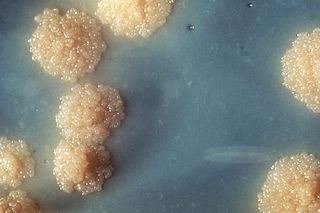
Mycobacterium tuberculosis, also known as Koch's bacillus, is a species of pathogenic bacteria in the family Mycobacteriaceae and the causative agent of tuberculosis. First discovered in 1882 by Robert Koch, M. tuberculosis has an unusual, waxy coating on its cell surface primarily due to the presence of mycolic acid. This coating makes the cells impervious to Gram staining, and as a result, M. tuberculosis can appear weakly Gram-positive. Acid-fast stains such as Ziehl–Neelsen, or fluorescent stains such as auramine are used instead to identify M. tuberculosis with a microscope. The physiology of M. tuberculosis is highly aerobic and requires high levels of oxygen. Primarily a pathogen of the mammalian respiratory system, it infects the lungs. The most frequently used diagnostic methods for tuberculosis are the tuberculin skin test, acid-fast stain, culture, and polymerase chain reaction.

Mycobacterium is a genus of over 190 species in the phylum Actinomycetota, assigned its own family, Mycobacteriaceae. This genus includes pathogens known to cause serious diseases in mammals, including tuberculosis and leprosy in humans. The Greek prefix myco- means 'fungus', alluding to this genus' mold-like colony surfaces. Since this genus has cell walls with Gram-positive and Gram-negative features, acid-fast staining is used to emphasize their resistance to acids, compared to other cell types.
Mycobacterium brumae is a rapidly growing environmental mycobacterial species identified in 1993. Aside from one 2004 report of a catheter related bloodstream infection no other infections by this organism have been reported. It was first isolated from water, soil and one human sputum sample in Spain.
Mycobacterium caprae is a species of bacteria in the genus Mycobacterium and a member of the Mycobacterium tuberculosis complex. The species is named after the caprines, the organisms from which M. caprae was first isolated. Prior to 2003, the species was referred to as Mycobacterium tuberculosis subsp. caprae. It is also synonymous with the name Mycobacterium bovis subsp. caprae.

Mycobacterium cosmeticum is a rapidly growing mycobacterium that was first isolated from cosmetic patients and sites performing cosmetic procedures.
Mycobacterium elephantis, a bacterium of the family Mycobacteriaceae, was discovered and isolated from a deceased elephant near India and may be linked to respiratory dysfunction. Organisms in the genus Mycobacterium are known to be aerobic and non-motile. Organisms within Mycobacterium belong to either the rapid growing group or the slow growing group. M. elephantis is classified as a rapid grower and relates most closely to Mycobacterium confluentis and Mycobacterium phlei.
Mycobacterium interjectum is a species of the phylum Actinomycetota, belonging to the genus Mycobacterium.
Mycobacterium avium complex is a group of mycobacteria comprising Mycobacterium intracellulare and Mycobacterium avium that are commonly grouped because they infect humans together; this group, in turn, is part of the group of nontuberculous mycobacteria. These bacteria cause Mycobacterium avium-intracellulare infections or Mycobacterium avium complex infections in humans. These bacteria are common and are found in fresh and salt water, in household dust and in soil. MAC bacteria usually cause infection in those who are immunocompromised or those with severe lung disease.

Mycobacterium kansasii is a bacterium in the Mycobacterium genus. It is an environmental bacteria that causes opportunistic infections in humans, and is the one of the leading mycobacterial causes of human disease after tuberculosis and leprosy.
Mycobacterium nebraskense is a slow growing, yellow, pigmented mycobacterium that was first isolated from human sputum at the University of Nebraska Medical Center, in Omaha, Nebraska, USA. Mycobacterium species are common causes of pulmonary infections in both humans and animals.
Mycobacterium wolinskyi is a rapidly growing mycobacterium most commonly seen in post-traumatic wound infections, especially those following open fractures and with associated osteomyelitis. Mycobacterium wolinskyi is clearly clinically significant, and occurs in the same settings as Mycobacterium smegmatis and members of the Mycobacterium fortuitum complex; they differ from members of the Mycobacterium fortuitum complex in the type of chronic lung disease they produce, with essentially all cases occurring in the setting of chronic lipoid pneumonia, either secondary to chronic oil ingestion or chronic aspiration. Etymology: Wolinsky, named after Emanuel Wolinsky in honour of, and in recognition for, significant contributions to the study of the non-tuberculous mycobacteria.
Mycobacterium vanbaalenii is a rapidly growing mycobacterium that can use polycyclic aromatic hydrocarbons. It was first isolated from petroleum-contaminated estuarine sediments and has been shown by 16S rRNA gene sequencing to be closely related to Mycobacterium aurum and Mycobacterium vaccae. M. vanbaalenii has potential use in the bioremediation of polycyclic aromatic hydrocarbon contaminated environmental sites. Etymology: vanbaalenii of Van Baalen, in memory of Dr Chase Van Baalen, late Professor at The University of Texas Marine Science Institute, Port Aransas Marine Laboratory, Port Aransas, TX, USA.
Mycobacterium pinnipedii is a member of the Mycobacterium tuberculosis complex which primarily infects seals. It is a slowly growing Mycobacterium. The species is named after the Pinnipeds, the organisms from which M. pinnipedii was first isolated.
Mycobacteria that form colonies clearly visible to the naked eye in more than 7 days on subculture are termed slow growers.
Mycobacterium lepromatosis is an aerobic, acid-fast bacillus (AFB), and the second known causative agent of Hansen's disease (leprosy). It was discovered in 2008. Analysis of the 16S rRNA gene confirms that the species is distinct from Mycobacterium leprae.
Mycobacterium triplex is a species of Mycobacterium.
Mycobacterium parmense is a species of Mycobacterium.
Mycobacterium senegalense is a species of Mycobacterium.
Mycobacterium seoulense is a species of Mycobacterium.

Mycobacterium ulcerans is a species of bacteria found in various aquatic environments. The bacteria can infect humans and some other animals, causing persistent open wounds called Buruli ulcer. M. ulcerans is closely related to Mycobacterium marinum, from which it evolved around one million years ago, and more distantly to the mycobacteria which cause tuberculosis and leprosy.




